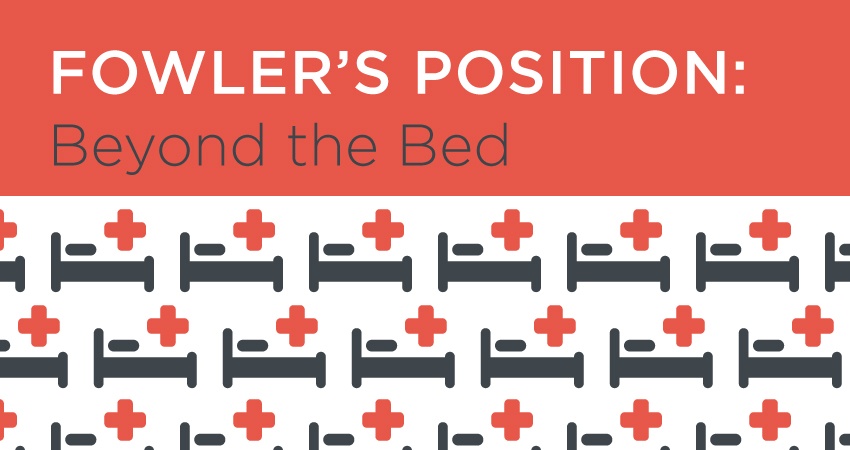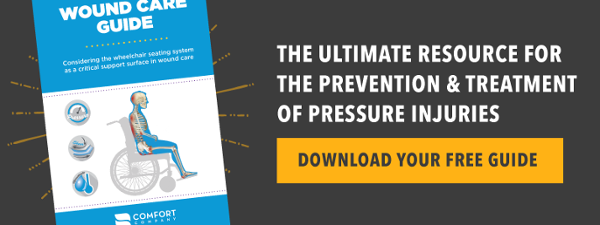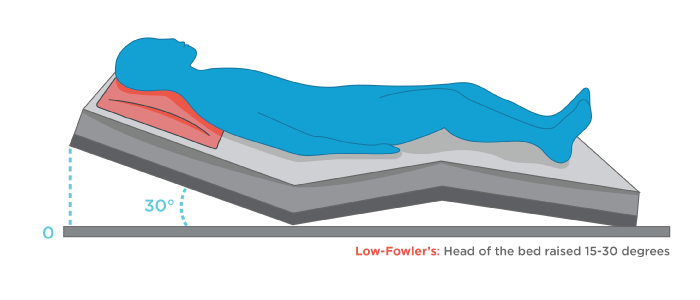
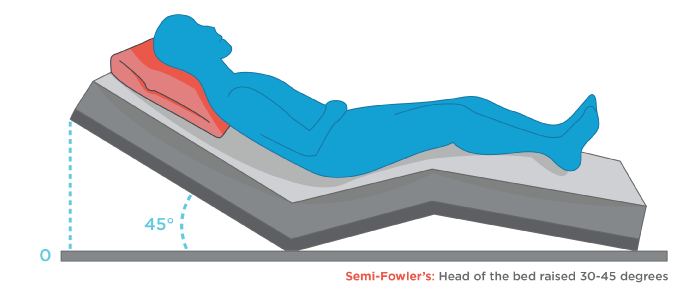
Standard Fowler’s 45-60 degrees
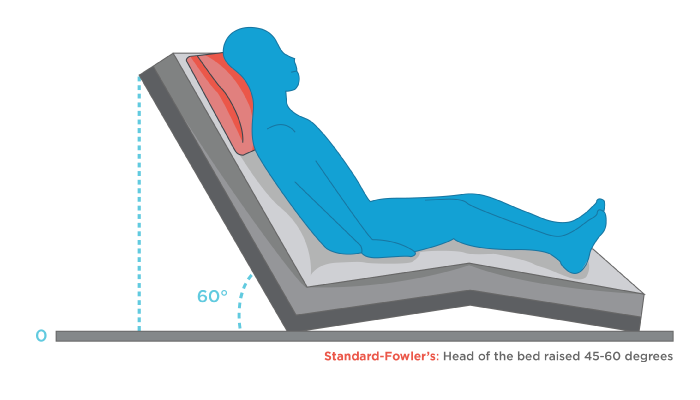
High/Full Fowler’s position 90 degrees
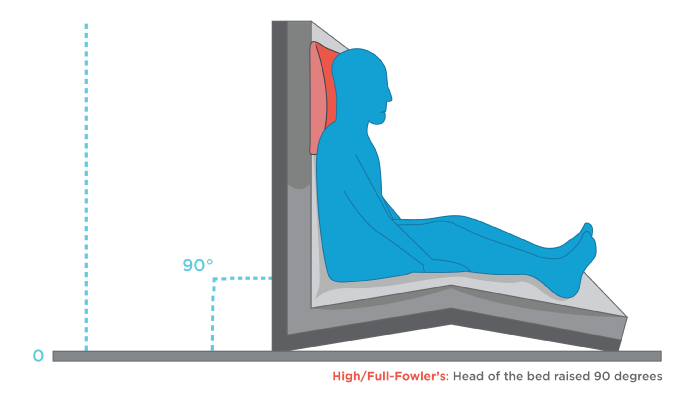
How Does Fowler’s Position Relate to Wheelchair Seating?
The position of interest in this blog is “High or Full” Fowler’s Position and is defined when a patient is placed in upright sitting at 90 degrees in bed and the knees may or may not be flexed.
Now you may be asking, why in the world I am going into so much detail to explain Fowler’s position when this is describing head of bed elevation while the patient is in the BED? Well, the explanation is simple. Seating and positioning needs to be understood by ALL disciplines involved with the patient. We need to be on board with the important role of angles in the bed AND wheelchair system to prevent wound development from pressure and shear.
One, if not the most, CRITICAL angle to understand in the wheelchair system is seat-to-back-angle. Seat-to-back-angle is where the seat support and the back support come together.
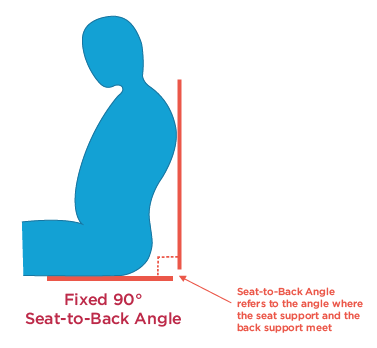
Relating seat-to-back-angle to Fowler’s position is an easy way for physicians and nurses to begin to translate a very well-known and researched area in their prospective fields to the seated posture in the wheelchair.
Opening and closing seat-to-back-angle is the same principle as raising and lowering the head of the bed to have the resident sitting in one of Fowler’s positions. The only difference is that one refers to the patient in bed and the other refers to the patient in the wheelchair. But the positive and negative effects of the angle of their body on the support surface are exactly the same! Here is how Fowler’s position relates to seat-to-back-angle.
|
Fowler’s Position in bed |
Seat-to-back angle in chair |
|
High/Full Fowler’s: head of the bed 90 degrees |
90 degrees of open seat-to back angle |
|
Standard-Fowler’s: head of the bed 45-60 degrees |
120-145 degrees of open seat-to back angle |
|
Semi-Fowler’s: head of the bed 30-45 degrees |
135-150 degrees of open seat-to back angle |
|
Low-Fowler’s: head of the bed raised 15-30 degrees |
150-175 degrees of open seat-to back angle |
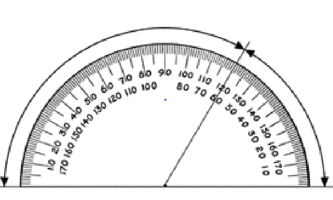
What’s the Problem for Wheelchair Positioning??
The commonly used manual wheelchair models that are typically seen in the nursing home settings, due to the cheap upfront cost have a fixed 90-degree seat-to-back angle. They are:
- K0001- Standard Wheelchair
- K0002 – Hemi Height Wheelchair
- K0003- Lightweight Wheelchair
These wheelchair models pose a huge threat to the elderly resident and any other wheelchair user in other settings that cannot achieve or tolerate that posture for long periods of time due to weakness, range of motion limitations at the hips/knees, or abnormal postures. When we try to force someone into this posture they begin to:
- Slide forward for rest and/or stability
- Thrust their hips up and over the cushion
- Complain of pain and discomfort in the pelvis or back
- Present with pressure on the bony prominences
- Be at risk of shear due to sliding out of that fixed 90 degrees
Does this sound like any of your patients???
The Solution for Fowlers Position
There is plenty of research out there that talks about the increased risk of developing a pressure injury on the sacrum and coccyx in patients that are left in High/Full Fowler’s Position for prolonged periods of time. This is equally true in a 90 degree seated posture!
Once we as healthcare professionals understand what an ideal seat-to-back-angle “brings to the table” in the wheelchair system, then we will have more justification to purchase the most appropriate products. We will all understand that preventing wounds and promoting healing of existing wounds includes an appropriate wheelchair seating system and involves the interplay between a wheelchair model, back support and cushion. When we leave out one of these pieces of the puzzle, we see an increase in wound development and prevention of healing of existing wounds. Let’s be aware of preventing harmful positions in the bed AND the wheelchair to ensure the best healing outcomes for our patients!
Kubota, S., Endo, Y., Kubota, M., & Shigemasa, T. (2017). Assessment of effects of differences in trunk posture during fowler's position on hemodynamics and cardiovascular regulation in older and younger subjects. Clinical Interventions in Aging, 12, 603-610. doi:http://dx.doi.org.ezproxylocal.library.nova.edu/10.2147/CIA.S132399
Makhsous, M., Lin, F., Hendrix, R. W., Hepler, M., & Zhang, L. (2003). Sitting with adjustable ischial and back supports: Biomechanical changes. Spine, 28(11), 1113-21; discussion 1121-2. Retrieved from http://search.proquest.com.ezproxylocal.library.nova.edu/docview/73332060?accountid=6579
Rondorf-Klym, L., & Langemo, D. (1993). Relationship between body weight, body position, support surface, and tissue interface pressure at the sacrum. Decubitus, 6(1), 22-30. Retrieved from http://search.proquest.com.ezproxylocal.library.nova.edu/docview/75555589?accountid=6579

Ana Endsjo, MOTR/L, CLT
Clinical Education Manager LTC Division
Ana Endsjo has worked as an occupational therapist since 2001 in a variety of treatment settings. She has mainly worked with the geriatric population, dedicated to the betterment of the treatment of the elderly in LTC centers. Her focus has been on seating and positioning and contracture management of the nursing home resident. With this experience, her hope is to guide other therapists, rehab directors, nurses, and administrators through educational guides, blogs, webinars, and live courses in her role as Clinical Education Manager for the long term care division.
With contributions by Stacey Mullis, ORT/ATP
